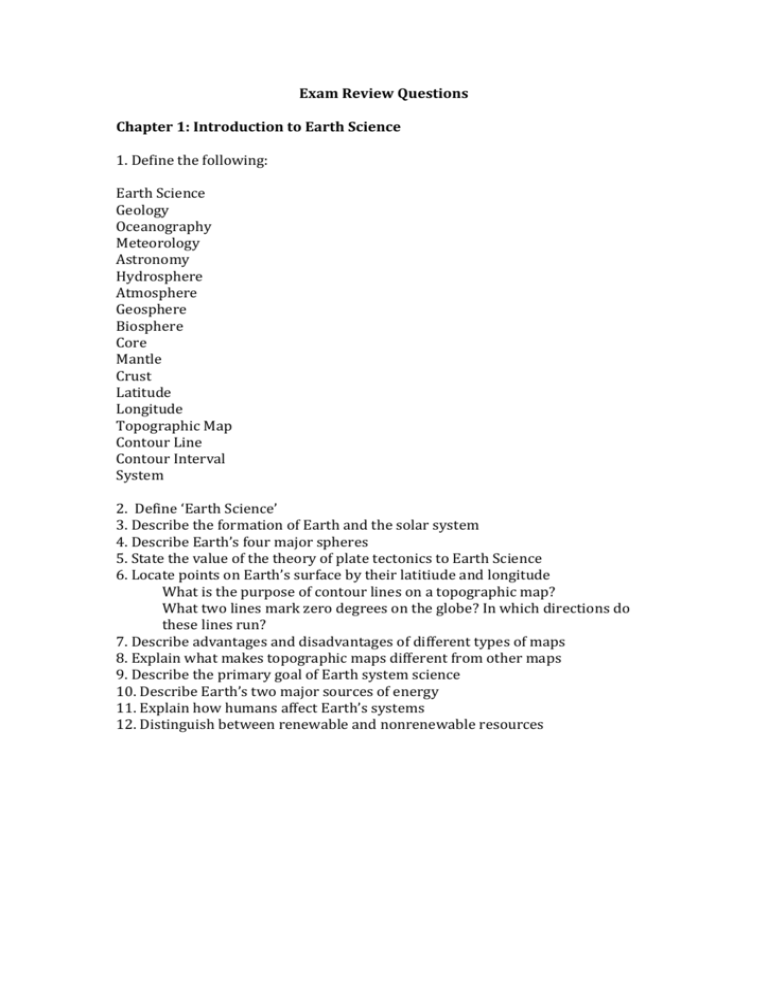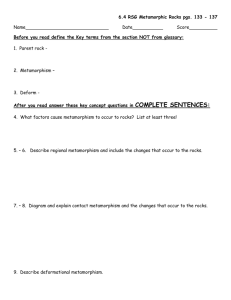ESS Exam Review Questions Q1
advertisement

Exam Review Questions Chapter 1: Introduction to Earth Science 1. Define the following: Earth Science Geology Oceanography Meteorology Astronomy Hydrosphere Atmosphere Geosphere Biosphere Core Mantle Crust Latitude Longitude Topographic Map Contour Line Contour Interval System 2. Define ‘Earth Science’ 3. Describe the formation of Earth and the solar system 4. Describe Earth’s four major spheres 5. State the value of the theory of plate tectonics to Earth Science 6. Locate points on Earth’s surface by their latitiude and longitude What is the purpose of contour lines on a topographic map? What two lines mark zero degrees on the globe? In which directions do these lines run? 7. Describe advantages and disadvantages of different types of maps 8. Explain what makes topographic maps different from other maps 9. Describe the primary goal of Earth system science 10. Describe Earth’s two major sources of energy 11. Explain how humans affect Earth’s systems 12. Distinguish between renewable and nonrenewable resources Chapter 2: Minerals 1. Define the following: Element Atomic number Energy level Isotope Mass number Compound Chemical bond Ion Ionic bond Covalent bond Metallic bond Mineral Silicate Streak Luster Crystal form Hardness Mohs Scale Cleavage Fracture Density 2. Explain how elements are related to minerals 3. Identify the kinds of particles that make up atoms 4. Explain the differences between ions and isotopes 5. Explain what compounds are and describe why they form 6. Compare and contrast the three major types of chemical bonds 7. List 5 characteristics of minerals 8. Describe the processes that result in mineral formation 9. Explain how minerals can be classified 10. List some of the major groups of minerals 11. Explain why colour is often not a useful property in identifying minerals 12. Distinguish between cleavage and fracture 13. Explain density and how it can be used to identify substances 14. Describe some other properties that can be used to identify minerals Chapter 3: Rocks 1. Define the following: Rock Igneous rock Sedimentary rock Metamorphic rock Rock cycle Magma Lava Weathering Sediments Instrusive igneous rock Extrusive igneous rock Porphyritic texture Granitic composition Basaltic composition Andesitic composition Ultramafic Erosion Deposition Compaction Cementation Clastic sedimentary rock Chemical sedimentary rock Metamorphism Contact metamorphism Regional metamorphism Hydrothermal solution Foliated metamorphic rock Nonfoliated metamorphic rock 2. 3. 4. 5. 6. 7. 8. Identify the three major types of rocks and explain how they differ Describe the Rock Cycle List the forces that power Earth’s Rock cycle Compare and Contrast Intrusive and Extrusive rocks Demonstrate how the rate of cooling affects an igneous rock’s texture Classify igneous rocks according to texture and composition Describe the major processes involved in the formation of sedimentary rocks 9. Identify the features that are unique to some sedimentary rocks 10. Predict where most metamorphism takes place 11. Distinguish contact metamorphism from regional metamorphism 12. Identify 3 agents of metamorphism and explain what changes they cause 13. Recognize foliated metamorphic rocks and describe how they are formed 14. Classify metamorphic rocks Chapter 12 and 13: Geologic Time and Earth’s History Be able to answer the Guided questions from your Summative Project








